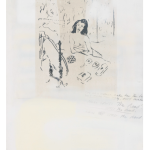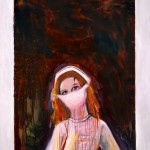Untitled (Good Painting-Brilliant)
2014
Signed and dated verso
Acrylic and collage on canvas
60 x 48 inches (152.4 x 121.92 cm)
Ex-collection
Acquired directly from the Artist
“It’s about knocking about in the studio and bumping into things.”
Richard Prince describing his career and methodology in a an interview from New York magazine 2005
After the early Monochrome Jokes and Cowboys we enter the second phase in Prince’s career. Beginning with Nurse and De Kooning paintings, evolving through the Canal Zone, After Dark and Tiffany paintings, we encounter the series known as The Good Paintings, white monochrome works that ask the question. What is white? As light, it is the apparent no-color that contains all colors except its antithetical no-color, black. But, as pigmentation, it rarely lacks some ghostly tint, and it is never without relative tone. Juxtapose any two whites and watch one turn gray. “Untitled (Good Painting-Brilliant) jumps out at you—if, that is, you have spent enough time for your perception to adjust, like eyes in the dark, to the pitch of excruciating discrimination that Prince demands. The exercise may offer its own reward, refining the viewer’s eye and mind, but it comes with ponderous intellectual baggage. Prince reductions of painting to basic protocols are engaging only to the extent that you regard painting as an art that is both inherently important and circumstantially in crisis. You must buy into an old story, which bears on Prince extreme, peculiarly sacramental standing in the history of taste. An avid collector and perceptive chronicler of American subcultures and vernaculars and their role in the construction of American identity, Prince has probed the depths of racism, sexism, and psychosis in mainstream humor; the mythical status of cowboys, bikers, customized cars, and celebrities; the push-pull allure of pulp fiction and soft porn; and the banalities of provincial life. Prince remains at once the consummate insider and the coolly detached outsider, transforming the bypassed elements of our culture into the unlikely new icons of our time. Applying his understanding of the complex transactions of representation to the making of art, he has evolved a unique signature filled with echoes of other signatures yet that is unquestionably his own.


 Untitled (Good Painting – Lucky ) (sold)
Untitled (Good Painting – Lucky ) (sold)
 Untitled (Good Painting-Brilliant)
Untitled (Good Painting-Brilliant)
 Untitled (sold)
Untitled (sold)
 Navy Nurse (sold)
Navy Nurse (sold)
 Untitled (Nurse) (sold)
Untitled (Nurse) (sold)
 Tender Nurse (sold)
Tender Nurse (sold)
 Emergency Nurse (sold)
Emergency Nurse (sold)
 Untitled (Joke : Missing and presumed dead ) (sold)
Untitled (Joke : Missing and presumed dead ) (sold)
 The Final Curtain (sold)
The Final Curtain (sold)
 Untitled (sold)
Untitled (sold)
 Untitled Can Painting (sold)
Untitled Can Painting (sold)
 Wipeout
Wipeout
 The Velvets (sold)
The Velvets (sold)
 I Never had a Penny to my Name (sold)
I Never had a Penny to my Name (sold)
 Untitled (Joke) (sold)
Untitled (Joke) (sold)
 Untitled (Joke) (sold)
Untitled (Joke) (sold)
 Untitled (sold)
Untitled (sold)
 Laura (sold)
Laura (sold)
 Upstate (sold)
Upstate (sold)
 The Girl Next Door
The Girl Next Door
 Untitled (sold)
Untitled (sold)
 Upstate (sold)
Upstate (sold)
 Silhouette Cowboy (sold)
Silhouette Cowboy (sold)
 Untitled (Cowboy) (sold)
Untitled (Cowboy) (sold)
 Untitled (Tire) (sold)
Untitled (Tire) (sold)